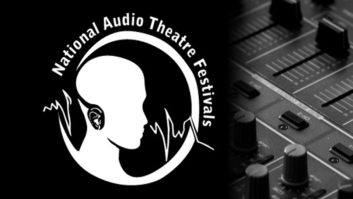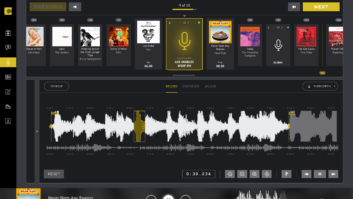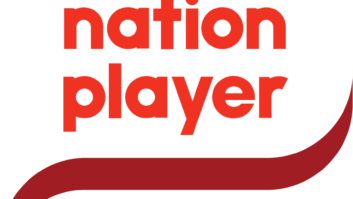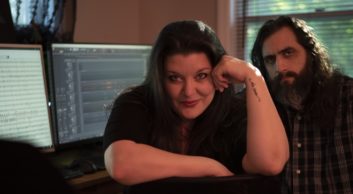
During the global pandemic and under lockdown, theatrical stage director and performer Liz Muller had to find a fresh medium to express her creative vision. In starting this new chapter, she co-produced four immersive audio podcasts — “Three Ghosts” and the trilogy “AFTERWORDS.”
“Three Ghosts” is a musical based on Charles Dickens’ “A Christmas Carol.” The cast included 46 people worldwide, and they all recorded independently during the height of the pandemic. It was released Dec. 20, 2020.
“AFTERWORDS” is described as “emotional, hilarious, scary, sad and totally vulgar stories.” Episode 1, The Mouse & The Cat, was released on May 31, 2021.
No stranger to immersive productions in a theatrical setting, it wasn’t a stretch for Muller to take the leap into audio storytelling. She already had the basis with Pipe Dream Theatre, the production company she co-founded with collaborator, partner and composer C. E. Simon.
Live theater, immersive audio
However, it was a distinct challenge to be able to take live theatrical productions and adapt them to immersive podcasts.
Theatrical productions often involve 40 to 50 actors speaking their lines, vocalists, musicians, as well as a composer and sound designer.
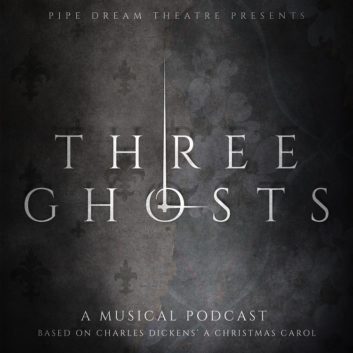 As Muller explained, it was no small feat to be able to corral all of that talent, remotely, let alone secure recordings.
As Muller explained, it was no small feat to be able to corral all of that talent, remotely, let alone secure recordings.
“To jump into 3D sound and decide to create immersive podcasts of that nature was an undertaking for certain,” said Muller. “Everyone’s got GarageBand, but a lot of people have never touched it, or they don’t have a microphone, or they’re recording on their iPhones, which is wild.”
She added, “Nobody is ever in a studio with me. I record the entire show, all parts, all voices, everything. And then I chunk it up into phrases, and I send it out to all of the cast members. And then they record themselves independently. Then I receive massive amounts of dialogue, and then compile it.”
Harnessing ambience
Muller said that because studio sessions weren’t possible, all of the voiceover work is recorded by the talent on readily available USB microphones and other devices. Studio treatments are encouraged, and audio is cleaned up afterwards.
“Most of our cast use their own USB microphones, since they are all over the world,” said Muller. “Some people are on their iPhones, and I’ve got them hanging a blanket up in a corner just to dampen the sound. And then we use effects and plugins, and get rid of gurgles, crackles, and whatever else is going on.”
Muller explained that there are a lot of variables when talent record their parts remotely.
“We still get these files with this crazy ambient noise and we’re like, ‘Are you at the airport?’” said Muller. “And it’s just like cleaning and mending, so that we can create the best product possible.”
Muller said that there’s also a challenge when you have so many recordings supplied from talent, all with different ambiences to contend with.
“Dealing with 50 different room ambiences is bonkers, and then getting that to sound like it’s even remotely in the same place. Sometimes it’s just trickery,” said Muller.
Theater informs storytelling
Muller said that C. E. Simon is involved in all aspects of the production. This includes writing, score, podcast sound design, Foley and mixing.
“He is the composer, he writes the script, he does all of the final podcast sound design,” said Muller. “He does all the Foley work and it comes from either libraries or subscription-based stuff. Or literally it’s us with a digital Tascam DR40, running around making noises and slamming doors and going up stairs, recording all of that.”
Muller and Simon both approach immersive audio storytelling much like they would approach a theatrical stage production or a musical.
“As a stage director, whenever I see words or hear music, I inevitably see the pictures of what people are doing,” said Muller.
“As Simon and I are working on the audio telling of a story, we look at each scene as we might as stage directors. Such as when there are two people in a room. They’re sitting down at a table and then they have to get up. There has to be movement. And now we’re just doing it with sound instead of visual.”
She added: “What we’ve learned is that it’s very hard to put a sound right in front of you. If there’s a human being in real life, right in front of you, you don’t hear sound like this. You hear sound globally, like it’s around you. A lot of times it’s more effective to pan it to the side or put it behind you because it’s a surprise.”
Some nuts and bolts
In terms of recording her own voiceovers, Muller uses a Shure Beta 58A mic through a Focusrite Scarlett Solo interface. The primary audio work is done in Logic Pro X. All of the assets from the remote talent are merged into Logic Pro by Muller. Muller then performs the pre-mixes for each scene, which includes the “comping” of the takes from the talent.
She puts together a first pass for timing, for tempo, and to capture the rhythm of scenes. Then she hands it off to Simon for further mixing and scoring. Simon uses the Accusonus ERA Bundle Standard for most of the audio repair. Once in the closing stages, Muller and Simon dial in the final mix of the podcast.
Muller said that if someone is planning to do immersive audio podcasts, especially on this scale, it’s a good idea to have others to help.
“Anybody jumping into 3D audio podcasts, get yourself a team,” said Muller. “It is not easy, and it’s time-consuming. It’s definitely different from working in stereo sound. But it’s so worth it.”
Ian Cohen covers pro audio, immersive audio, storytelling and music creation. He’s producer/host at Malibu’s 99.1 FM KBUU.





